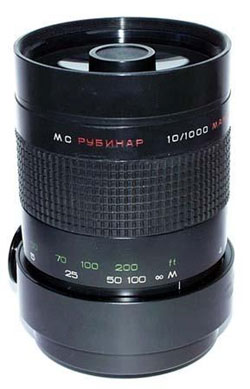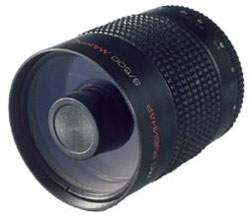
SLR Cameras Zenit / Kiev
Maksutov Mirror Optics Macro / Telephoto Lens
The First in Invention,
The First in Use,
The first in Versatility,
The First in Quality,
The First in Low Prices,
The First in Sales All Over the World.
Origins:
Invented by the Russian optician Dmitri Maksutov (1896-1964), in 1942 the Maksutov reflecting telescope is a type of catadioptric telescope that uses a either a spherical primary mirror in conjunction with a meniscus-shaped corrector outer lens at the entrance pupil in order to correct spherical aberration.Thus, avoiding the high costs of parabolic or hyperbolic mirror manufacturing. This is the basis of all mirror telephotos of Zenit line.

ASTELE™ 150 OTA LOMO Telescope - A1800.
Commercial models differ from the similar Schmidt-Cassegrain telescope design in that the meniscus-shaped corrector plate allows for the use of an easily produced spherical secondary mirror instead the hyperbolic mirror required for the Schmidt telescope. The Maksutov meniscus corrector plate is also much easier to make than the Schmidt mirror.
Technical Characteristics:
All Russians Maksutovs made today have spherical surfaces. Designs have different spherical surfaces which use a small hole in the reverse side of the corrector meniscus as the secondary mirror, so producing images as good as an aspheric system. The reason they are made and left spherical is to enable them to be mass produced on relatively simple polishing machines, lowering production costs and increasing production capabilities.Slight adjustments are introduced by skilled opticians in the workshop.
The Maksutov design also has excellent correction for off-axis aberrations such as coma, which is a significant problem in the simpler Newtonian reflecting telescope.


Light path inside a Maksutov Telescope Perspective and Cross Section.
Because the obstruction caused by the central smaller secondary mirror we see at defocused poins small bright points like doghnuts. The image contrast and sharpness is very high, higher than to refractors of the same aperture. The main advantage, besides the lighter weight and smaller size, over reflecting telescopes is that Maksutov Optics and Telescopes are largely free from chromatic aberration making them the ideal optic for planetary and detailed terrestrial observations.
The chief disadvantage of the Maksutov design is that it does not scale up well to large apertures (>250mm/10 inches), since the corrector plate rapidly becomes prohibitively large, heavy and expensive as the aperture increases. However specialist manufacturers do create models beyond 14 inches in aperture.
The inherent high focal ratio of the Maksutov design obviously provides high powers and a narrower field of view. This makes them unsuitable for wide-field Astrophotography but superb at lunar and planetary imaging. They are also very adept at imaging tightly packed formations such as globular clusters and at splitting double stars.
Description:
All MC MTO and MC Rubinar Mirror Telephoto Lenses with multilayer coatings of optical surfaces serves as interchangeable one for the Zenit still cameras with 24x26 mm format, 45.5 mm working distance. The lens is used for black-and-white and colour photographs. These lenses have a macro-limit, varying with the focal length. The using of the tripod makes it possible to arrange the frames by turning the lens with the camera into the special ring. The lens is designed for photo hunting, remote objects, architectural details, sporting contests and other. Before the lens using make a careful study of operation instructions.
All MC MTO and MC Rubinar Mirror Telephoto Lenses are furnished with a set of colour filters, and supplied in a handy leather carrying case.
"CAUTION" these lenses may not work on all 35mm cameras with built in flash or other protruding devices on the front. The lens diameter at the mounting flange is 125mm or 62.5 mm radius. Measure your camera from the center of the lens mount to determine if any camera part extends more than 4 mm in front of the mounting ring within this radius. For example, the lens can not be used on the Canon EOS 10D camera unless you get the Teleconverter or some other Extension Tube. See more about how to use lenses with various cameras here >>
You may use the lens as Hand Telescope together Tourist - FL (an eyepiece attachment). Or with angle viewer (to form a table telescope).

You may also use the lens for Astrophotography if you purchase TeleconverterTKL2. The set increases the focal length twice the focal length value. So a 1000mm become a 2000mm. A 500mm a 1000mm and a 300mm a 600mm. Respectively
Lens design
The thread in the front part of the lens serves for screwing in the lens hood and attachments. The distance scale serves for approximate focusing; the distance values are shown in metres and in foot. The focusing is performed by rotation the ring. Accurate focusing is performed over the ground glass. The ring serves for fixing the lens on the tripod and for turning the frame on 90° during the arrangement of the subject.
Operating procedure
Before
installation of lens on the camera take off the rear lid. Screw in the mirror
lens in the camera as far as it will go.
Owning to the great mass of the lens it is recommended to use a tripod. The
using of the tripod makes it possible to turn the frame on 90°; in this case the
lens with the camera andthe turning ring remains immovable.
The lens focusing is performed by rotation the focusing ring until the sharpest
possible image of the object is obtained on the ground glass. The distance range
from 6 m to 4 m is a macrophotography and the scale of photography is from 1:6
to 1:4.
The delivery set includes five light filters:
UV-1.4x - is a colourless one used to weaken the influence of
ultraviolet rays. In mountainous regions and on water it makes it possible to
cut out the ultraviolet rays. It used at black-and-white and colour photography.
O-4x - is an orange one ensures the obtaining of a contrast image
(black-and-white photography), weakes the influence of atmospheric haze.
YG-8x - is a yellowgreen one used to correct the tone rendition in
black-and white photography on panchromatic film both with natural and artifical
lighting.
The lens hood is used to remove the beams of light sources. Screw in the lens
hood on the lens over the thread.
Lens care
Photographic lens is a complicated and sensitive optical instrument that needs careful treatment. Disassembling of the lens for repairs is admitted only in the special repair shop. The lens is designed for photographing at the temperature from -15°C to +45°C. when bringing the lens from the cold into a warm room, don't open its case to prevent fogging of optical details. Allow the lens to warm up in the closed case during 3 hours. When not using the lens close its lids. Keep the lens in its case. Protect the lens from blows, moisture, dirtying and sharp fluctuation of temperature. Take care of the coated surface of the lens; mousture that is found for a long time of the coated surfaces may spoil the coating film. Don't touch the optical details. Remove dust from surface with a clean soft degreased hair brush. Dirty spots are best removed with a cotton wool wad on a small wooden stick. It is necessary to slightly moisten a wad in rectified alcohol, ether or mixture of these substanses. The large dirtying remove with several wads. Clean the surface with circular motions, gradually moving from the center of the lens to its edges.
 |
MC Rubinar 10/1000 Macro Telephoto Lens
|
|
Focal length, mm |
1000 |
|
Geometrical relative aperture |
1:10 |
|
Angular field of view, deg. |
2.5 |
|
Focusing limits, m |
from 4 to infinity |
|
working distance, mm |
45.5 |
|
Resolving power at
infinity, mm-1: |
50 |
|
Connecting with the
camera: |
thread M42x1 |
|
Connecting thread for light filters, attachments and lens hood |
M116x1 |
|
Connecting thread for tripod, inch |
1/4 |
|
Slip joint for attachments, mm |
122 |
|
Overall dimensions at
infinity, without lids, max, mm |
210 |
|
Mass without lids, max, kg |
2.3 |
![]() Delivery
set:
Delivery
set:
|
Lens |
1 pc |
|
Light filter UV-1.4x |
1 pc |
|
Light filter O-4x |
1 pc |
|
Light filter YG-8x |
1 pc |
|
Front lid |
1 pc |
|
Rear lid |
1 pc |
|
Lens hood |
1 pc |
|
Case |
1 pc |
|
Operation instructions
|
1 copy
|

MTO-11CA 10/1000 Telephoto Lens
 Specifications:
Specifications:
|
Focal length, mm |
1000 |
|
Maximum aperture |
f10 |
|
Angle of view, deg. |
2,5 |
|
Focusing range, m |
8 - inf |
|
Working distance, mm |
45,5 |
|
Camera mount thread |
M42 x 1 |
|
Connecting thread for light filters, attachments and lens hood |
M116x1 |
|
Resolution, mm-1, min.: |
|
|
Light-transmission factor, min. |
0,77 |
|
Light-diffusion factor, max. |
0,03 |
|
Overall dimensions, mm, max. |
Diam. 126 x 238 |
|
Weight, kg, max
|
1,95
|

MC Rubinar 5.6/500 Macro Telephoto Lens
 Specifications:
Specifications:
| Focal length, mm | 500 |
| Geometrical relative aperture | 1:5,6 |
| Angular field of view, deg. | 5 |
| Focusing limits, m | from 2,2 to infinity |
| working distance, mm | 45,5 |
| Connecting with the camera | thread M42x1 |
| Connecting thread for light filters, attachments and lens hood | M105x1 |
| Connecting thread for tripod, inch | 1/4" |
|
Overall dimensions at
infinity, without lids, max, mm length diameter |
130 113 |
| Mass without lids, max, kg | 1,6 |
![]() Delivery
set:
Delivery
set:
| Lens | 1 pc |
| Light filter UV-1.4x | 1 pc |
| Light filter O-4x | 1 pc |
| Light filter N-4x | 1 pc |
| Front lid | 1 pc |
| Rear lid | 1 pc |
| Lens hood | 1 pc |
| Case | 1 pc |
|
Operation instructions
|
1 copy
|

MC Rubinar 8/500 Macro Telephoto Lens
 Specifications:
Specifications:
|
Maximum Aperture: |
1:8 |
|
Focal Length, mm: |
500 |
|
Angle of View: |
5° |
|
Lens Mount: |
M42x1 |
|
Mount thread for Attachments: |
M77x0.75 |
|
Operating length, mm: |
45.5 |
|
Focusing limit, m: |
2.2 |
|
Dimensions, (Diameter x Length): |
81x99 |
|
Weight, kg:
|
0.55
|

3M-5CA 8/500 Telephoto Lens
 Specifications:
Specifications:
|
Focal length,mm |
500 |
|
Maximum aperture |
1:8 |
|
Angle of view, deg. |
5 |
|
Minimum focusing range,m |
4 |
|
Working distance,mm |
45,5 |
|
Camera mount thread |
M42 x 1 |
|
Mount thread for screwed-in attachments |
M72 x 0,75 |
|
Resolution, mm-1, min |
|
|
Light transmission factor, min. |
0,75 |
|
Light diffusion factor, max. |
0,03 |
|
Overall dimensions, mm |
Diam. 83 x 139 |
|
Mass, kg, max
|
0,620
|

MC Rubinar 4.5/300 Macro Telephoto Lens
 Specifications:
Specifications:
|
Maximum Aperture: |
1:4.5 |
|
Focal Length, mm: |
300 |
|
Angle of View: |
8° |
|
Lens Mount: |
M42x1 |
|
Mount thread for Attachments: |
M77x0.75 |
|
Operating length, mm: |
45.5 |
|
Focusing limit, m: |
1.8 |
|
Dimensions, (Diameter x Length): |
81x99 |
|
Weight, kg: |
0.55 |